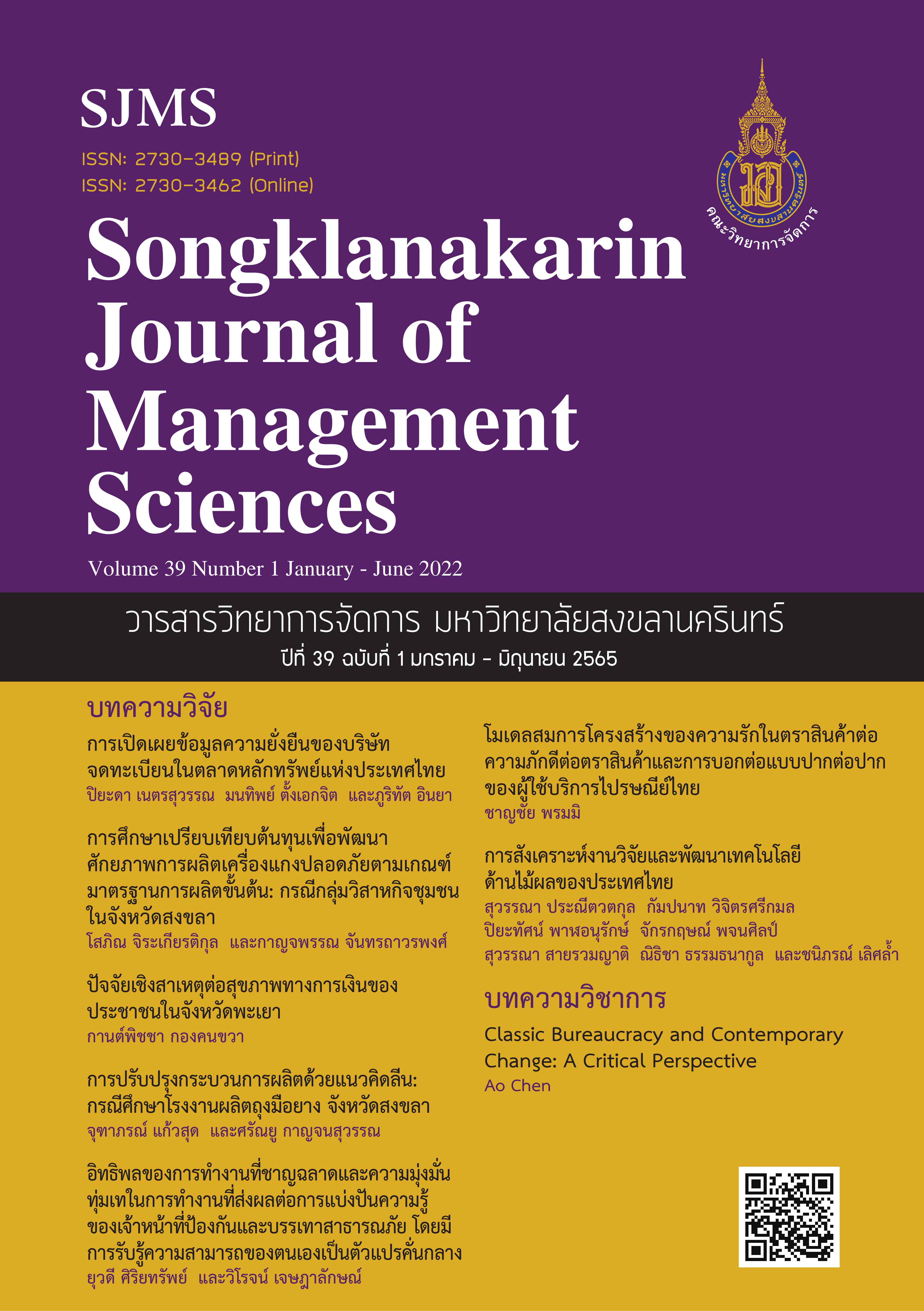Improving the Production Process using Lean Concept: The Case of Gloves Manufacturer in Songkhla Province
Main Article Content
Abstract
This research aims to investigate how applying the Lean concept can help improving the gloves manufacturing process in a case study of a company in Songkhla province, Thailand. The study begins by identifying the problems and their causes, using the 5W1H questioning technique to analyze each step of the glove-making process, by collecting data from 11 key informants through participant observation and focus group methods. Lean tools were applied to create the value stream mapping, and the ECRS (Eliminate, Combine, Rearrange, and Simplify) method was used to improve the processes by eliminating unnecessary processing steps, adjusting several procedures so that they were able to be performed simultaneously, and using new methods. The research results indicated a 2.56 percent reduction of work in the process. Consequently, processing time was shortened from 229.92 hours to 217.72 hours, which is equal to a reduction of 5.31 percent. This result shows that Lean is a concept leading to reducing waste, resulting in a faster organization process, and a reduction in the delay in delivering finished products to customers. Therefore, the researcher recommends that entrepreneurs place emphasis on increasing operational efficiency by decreasing waste caused by repetitive and unnecessary work in the process of manufacturing gloves using the concept of Lean, as it has been shown to be potentially useful for this company.
Article Details

This work is licensed under a Creative Commons Attribution-NonCommercial-NoDerivatives 4.0 International License.
All published articles are SJMS’s copyright. The editorial board allows all published articles to be copied, excerpted, or disseminated with academic citation.
References
Bank of Thailand. (2018). Report of important agricultural product prices in Thailand Quarter 2/2018. Retrieved June 15, 2019, from https://www.bot.or.th
Buakaew, N. (2015). Introduction to lean manufacturing. Bangkok. SE-ED.
Chen, J., Lee, H., Chiu, S., & Tseng, B. (2011). Productivity improvement with lean production in glove manufacturing industry. The paper presented at the 3rd International Conference on Advanced Design and Manufacture, Nottingham.
Lu, T., Wu, M., & Wu, C. (2018). Improve production process performance by using lean Management a case study
of lady underwear. The paper presented at the 18th International Conference on Electronic Business, China.
Nimitphuwadon, N. (2014). Waste reduction in warehousing process with lean concept case study: furniture industry. Journal of Business Administration Lampang Rajabhat University, 7(2), 66-72.
Ruekkasaem, L., & Nivasanon, C. (2019). Implementation of lean production a fashion clothing factory. Journal of Industrial Management Phranakhon Rajabhat University, 2(2), 45-46.
Russell, R., & Taylor, B. (2011). Operation management. Virginia. John Willey & Sons.
Saetung, S., Thirasirikul, J., & Premchaiswadi, W. (2018). A Study of components of total quality management and lean manufacturing system affecting management efficiency of hard-disk-drive industry in Thailand, Journal of Social Academic, 11(3), 360-370.
Srisungsuk, K. (2009). Waste reduction by lean six sigma approach in micro coaxial cable manufacturing process. (Master’s Thesis). Chulalongkorn University, Bangkok.
Suhardi, B., Anisa, N., & Laksono, P. (2019). Minimizing waste using lean manufacturing and ECRS principle in Indonesian furniture industry, Cogent Engineering, 6(1), 1-13.
The Office of Industrial Economics and Plastics institute of Thailand. (2018). Industry report production of rubber and rubber products in Thailand. Retrieved June 30, 2019, from http://rubber.oie.go.th/box/Article/56638/.pdf
Wajanawichakon, K., Srisawat, P., & Thippo, W. (2015). Application of value stream mapping for Increasing an efficiency of logistics and supply chain of automatic rice steamer in Ubonratchathani, Journal of Industrial Management Technology Ubon Ratchathani Rajabhat University, 8(2), 2-3.

